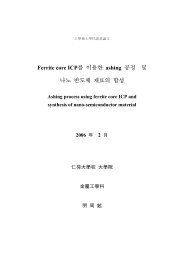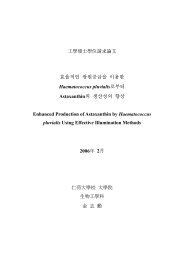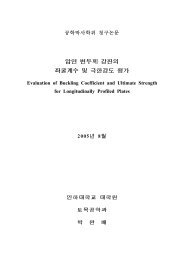저작자표시-비영리-변경금지 2.0 대한민국 이용자는 아래의 조건을 ...
저작자표시-비영리-변경금지 2.0 대한민국 이용자는 아래의 조건을 ...
저작자표시-비영리-변경금지 2.0 대한민국 이용자는 아래의 조건을 ...
You also want an ePaper? Increase the reach of your titles
YUMPU automatically turns print PDFs into web optimized ePapers that Google loves.
3. 5. Foam behaviors and cell geometry<br />
Figure 7 presents optical micrographs of the cross-sectional surfaces<br />
of the PBS nanocomposite foams with 2 wt% MWNTs content<br />
produced via the SOAM method and foamed for 5 min as a function of<br />
temperature and CBA content. All nanocomposites foamed by CBA<br />
showed a homogeneously closed-cell structure, suggesting that the<br />
presence of well-dispersed MWNTs plays an important role in<br />
increasing melt viscosity of the nanocomposite so as not to destroy the<br />
cell walls, as well as providing the nucleating sites for cell formation.<br />
We note that the cell size increased with more adding the amount of<br />
CBA, also increasing the temperature. If a proper melt viscosity that<br />
restricts the expansion of cells is established, the cell geometry will be<br />
strongly affected by the aforementioned two factors. From the optical<br />
microscopy data, various morphological parameters of PBS/2 wt%<br />
nanocomposite foams obtained by the SOAM method can be<br />
quantitatively determined, as seen in Table 1. The post-foamed mass<br />
density tended to decrease with an increase in both the CBA content<br />
and temperature as a result of expansion of the PBS nanocomposite<br />
foam, while the neat PBS density is 1.268 g/cm 3 . All nanocomposite<br />
foams exhibit a structure ranging from 154.72 μm to 406.30 μm. The<br />
16







